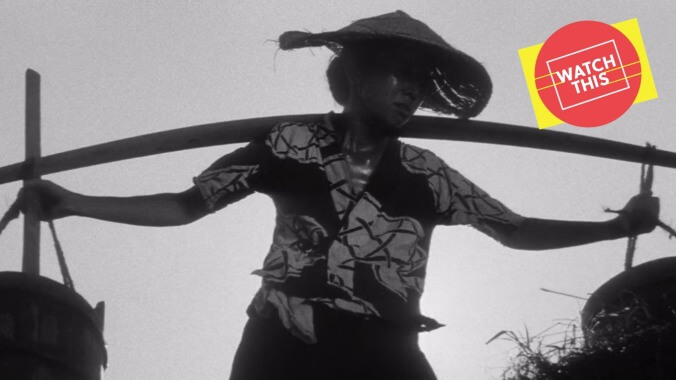If you think you’ve got it tough, try hauling water up a cliff all day

Watch This offers movie recommendations inspired by new releases, premieres, current events, or occasionally just our own inscrutable whims. This week: Shhhhhh! We’re celebrating movies with little to no dialogue.
The Naked Island (1960)
For much of the history of humanity, life looked a lot like it does for the protagonists of The Naked Island. They’re subsistence farmers, scratching out a living on the side of a scrub-covered Japanese island, going through an endless cycle of toil punctuated by brief moments of exhausted respite. And things are especially rough for the isolated family the film follows: Every single day, multiple times a day, the mother and father have to row across a wide channel—an act that looks very tiring all on its own—to collect water, row back to the island, and haul the heavy buckets up the sheer side of a rocky cliff. One misstep, and they have to start all over again. It really puts that pile of dishes you don’t feel like washing into perspective.
Director Kaneto Shindō was himself the son of farmers, and he had great respect for manual labor, especially agricultural labor, which he described as “the fundamental way of life for human beings” in a 2011 video interview. This respect is reflected in the film’s unique structure, which captures the meditative mental state of being deeply absorbed in a repetitive task for a long period of time. Some moments pass in a blip, while others are seemingly stretched into infinity. No one says anything, because there’s nothing to say: Yesterday was the same as today, and tomorrow they’ll get up and do it all again. Besides, as Shindō says in that same interview, “A film isn’t words. It’s images.”
For its first 30 minutes, The Naked Island could be set in any period of human history; it’s not until the family puts on their one set of nice clothes for a trip into town that we realize that the story takes place in the present day—the present day of 1960, but modern times nonetheless. Shindō’s technique is also thoroughly modern, sidestepping the need for dialogue with cleverly placed jump cuts (conceived independently of Jean-Luc Godard, who was experimenting with the same technique in France) and using extreme high and low angles to make his subjects alternately tiny as ants and huge as gods. Sealing the compact between ancient and modern is Hikaru Hayashi’s score, which mimics the natural sounds of sea and sky to enhance the audience’s emotional reactions to the events unfolding on screen.
For Shindō and his regular company of actors and crew, shooting the film in Mihara, a small coastal town about an hour’s drive from Hiroshima, must have seemed as difficult and futile as—if less back-breaking than—hauling heavy buckets of water up a cliff all day. Kindai Eiga Kyokai, the production company Shindō had co-founded 10 years earlier, was on the edge of collapse, and he was gambling it all on this dialogue-free cinematic tone poem—a less-than-commercial concept in any era, but especially out of step with Japan in the ’60s, as the country was in the midst of an explosion of consumerism and urbanization. But the crew’s faith in Shindō was ultimately rewarded, as the film won major awards abroad and saved Kindai Eiga Kyokai from bankruptcy. Quiet dignity does occasionally pay off.
Availability: The Naked Island is currently streaming on The Criterion Channel. It can also be rented digitally from Amazon, Google Play, iTunes, YouTube, or VUDU.